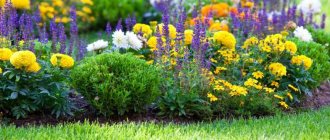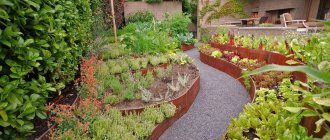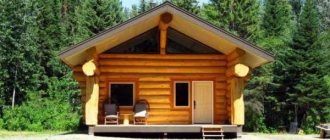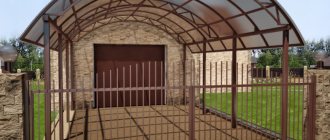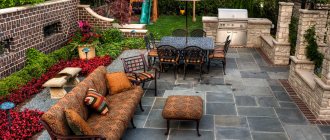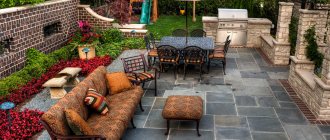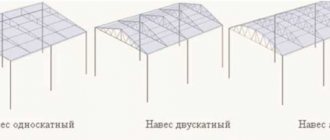Owners of private houses are increasingly realizing every day that in order to create comfortable living conditions, it is important to pay attention not only to the main building, but also to the garden plot and its design. They do not count on the help of landscape designers and specialists, trying to independently create a creative fairy-tale garden, which is impossible to imagine without flowers. If you plan to build flower beds with your own hands in the courtyard of a private house, then it is important to choose the right design of flower beds, taking into account their appearance and shape, location and materials that will be used. How to make a beautiful flower bed? Find out about it with us.
From concrete blocks
If you have a few concrete blocks left over from construction, use them to create a small flower bed. The area underneath should be well leveled.
The material plays the role of a flowerpot, so before planting, place a drainage layer on the bottom, and then fill the container with fertile soil. The solution is not used in this case, since the blocks are quite heavy.
Despite the fact that the flowers look quite organic against the background of concrete, the structure can be painted if desired.
Land preparation and planting
After the location for the flowerbed has been selected, it is worth deciding what plants will be planted on it. And depending on this, the soil is already prepared.
Attention: most plants are very picky about the type of soil. Therefore, for each individual variety, its own soil composition is prepared.
There are basic rules for preparing fertile soil that suits most plants:
- To begin with, the size of the future flower bed is determined, and pegs are driven around its perimeter, onto which a rope is pulled. In the future, it is worth laying a border along these boundaries.
- The fenced-off area is cleared of weeds, stones and branches, and carefully dug up, about half a meter deep. After digging, the soil should be loosened.
- Next you will need to determine the acidity of the soil. If it is too acidic, additional lime is added.
- Since plants love nutritious soil, organic and mineral fertilizers are periodically applied to the soil.
From bricks
In landscape design, not only stones, but also bricks are often used. Uneven aged products look most harmonious: their appearance is closer to natural motifs.
Using bricks that provide protection from weeds, you can create a multi-tiered flower bed as in the photo: it will take up little space, but will look impressive and unusual.
The best places for a flower bed on the site
Ideally, space for a flower bed is left during the construction of a private house. Unfortunately, not everyone thinks about this in advance, which means that flower beds need to be integrated into the established landscape design, where there is already a residential building and other buildings, garden paths and trees. However, it is almost always possible to find a free space for a flower bed, and when choosing a good location for a flower bed, you need to take into account the following points:
- Flowers and ornamental plants do not like wind and drafts, which means it is better to place them in a place where the influence of wind will be minimal.
- Almost all flowers are sun-loving, which means they need to be placed on the south side of the site. At the same time, there are plants that do not tolerate prolonged insolation and are best placed on the western or eastern side of a private house.
- The flowerbed cannot be placed in the lowlands of the site, as they do not tolerate stagnation of moisture in the soil.
- Excess moisture is dangerous for the root system, therefore, the flowerbed should not be placed in a place where rainwater flows (near the roof of a private house or other buildings).
Based on everything that was said earlier, we can conclude that it is best to place a flowerbed in the front garden in front of the house, because the flowers will be noticed not only by household members, but also by their guests. Designers recommend placing a flower bed near the porch of the house; an unusual and stylish solution would be to create a carpet composition where flowers create words and phrases (“Hello”, “Have a nice day” or “Welcome”). However, experienced gardeners can make such a composition; first, it is better to limit yourself to the simpler options shown in the photo. If the site is dominated by tiles and concrete, then to arrange a flower bed you can use containers that raise the flowers above ground level.
From furniture boxes
An even more unconventional (and economical) approach to decorating a small patio is to use old wooden furniture. Drawers from a chest of drawers that have fallen into disrepair will serve as an excellent basis for a flower bed. As if forgotten on the street and overgrown with flowers, they will definitely attract attention and become the highlight of the garden.
Wooden boxes must be treated with moisture-proofing compounds: paint, varnish or stain.
Predominant plants
When creating a beautiful flower garden design, it is important to take a responsible approach to the choice of flowers. It is advisable that they are not too demanding to care for. Mixborders are usually made in garden flower beds. The following plants are planted here: conifers, annuals, perennials, and various ornamental shrubs. Various fences and stones are used as decoration.
When planting flowers in the yard, attention is paid to their height, spreading nature, flowering time, color scheme, and decorativeness. Most gardeners prefer perennials, since with them you don’t have to think about planting every year, and there is a huge range of different varieties and types.
For spring flower beds the following are selected:
- crocuses;
- snowdrops;
- dicentra;
- daffodils;
- periwinkle.
Summer flowering plants include:
- violets;
- delphiniums;
- spurge;
- primrose.
Popular autumn bloomers are:
- astilbe;
- cornflowers;
- asters;
- gladioli;
- pelargonium.
Vertical flower beds
This is the most practical option for decorating a mini-plot. They save space and decorate the local area. There are many ways to create a vertical garden: both ready-made purchased structures and available materials are suitable for this. Suitable for hanging and climbing plants:
- transport pallets suspended or placed against a support;
- flowerpots or plastic bottles under the roof of a house or gazebo;
- multi-tiered structures made of ceramic pots, as if strung on top of each other;
- hanging reusable pockets on the fence.
What and how to make a fence from
Without a beautiful border, not a single flower bed will look attractive and aesthetically pleasing. For these purposes, wooden blocks, stones, and concrete blocks are used.
Picket fence borders look very original. To do this, one edge of the lumber is sharpened (for convenient fixation in the ground). The boards themselves should be placed tightly to each other to create a beautiful and convenient fence for the flower bed.
Original and wicker fences. To install them, posts are dug around the perimeter of the flowerbed and intertwined with vines. Here you can use different weaving techniques. If you make sure that the branches do not lie close to each other, you will get a beautiful openwork weave. Stone curbs are also a good option. To do this, a small trench is made along the contour of the flower bed, and bricks, stones, and sandstone are installed in it.
Attention : a fence can give a finished look to any flower bed.
In the basket
Weaving looks advantageous not only in the apartment, but also in the garden: to create an aesthetic flower bed, you should use a large basket, for example, for storing and carrying firewood. Even if the product has fallen into disrepair, its shortcoming will be beneficial: a leaky bottom will allow the roots to grow more freely. Make a composition of several baskets to make the flower bed look more picturesque.
If there are no ready-made baskets, braid the flower garden with vines. Flexible branches of willow, willow or birch are suitable. The wicker “handle” will serve as a support for the loaches.
Flowerbed design: choosing the type and shape
Having determined the place for the flower bed, it’s time to decide on its type and shape, and the materials used to arrange the flower garden. In general, experts distinguish two types of flower beds:
- Regular - flower beds with low plants that bloom at the same time. Here, strict and clear lines of the floral design are observed, which must be ensured with careful and constant care.
- Irregular flower beds are flower beds filled with long-flowering plants of the same variety or flowers with staggered flowering periods, thanks to which the flower bed will bloom and delight throughout the season (year).
There are quite a lot of varieties of flower beds based on their shapes and dimensions. When choosing the parameters of a flowering island, you need to focus on the size of the site and the style of the landscape. As for the shape, those new to the world of gardening are better off sticking with simple geometric shapes (round, square or rectangular). Separately, it is worth noting the corner flower beds, which fit perfectly into the space between the porch and the wall of the house, garage and bathhouse, housing and other neighboring buildings. A stylish solution would be to use a structure made of gabions or high flower beds.
Flower garden is a general concept that includes the following types:
- Alpine slide is a flowerbed that combines flowers and stones, which is decorated in several “floors”.
- Rockery is a spectacular rocky garden of free form.
- A flower border is a narrow ribbon of low-growing flowers of one or more species, used to frame garden paths or other flower beds.
- Mixborder is a composition of any shape, which can contain not only flowers, but also shrubs or trees.
- Rabatka is a long flower bed in the form of a strip, the width of which is 0.5-1.5 meters. Usually several types of ornamental plants are planted here.
In order for the flower bed to be stylish and attractive, it is important to choose the material for its fencing. A decent frame has a strong influence on the design of a flower garden and can completely change its visual perception. As a fence you can use: concrete blocks, wickerwork, wooden elements, slate and other original materials (old barrels, tires, bicycles, flowerpots, etc.).
From flowerpots
Continuing the topic of damaged and broken things, let's pay attention to broken ceramic pots. They are great for creating an “overturned” flower bed. Small creeping flowers seem to pour out of the container, creating a complete composition: without a flowerpot, the planted plants would look lonely.
For a stream bed, you can use jugs, old cast iron pots found in the attic, and saucepans.
Maintain balance and make sure that the small courtyard does not turn into a warehouse of broken things, losing its decorative effect.
Types of flower beds
All flower beds differ in: shape, size, content. Various flower beds, ridges, rock gardens, rose gardens and borders also belong to flower beds. By variety, all flower gardens are divided into: large, medium, small, strict, classic, carpet, ceremonial, ornamental, seasonal, permanent, annual and so on. They are decorated with the help of annuals, perennials, trees, and shrubs.
There are 8 main basic varieties of flower beds:
- Flowerbeds . Typically, these decorative compositions have clear geometric shapes (oval, circle, rectangle). Flower beds differ in the height of plants, their color scheme, and seasonality of flowering. For classic flower beds, mixing about 5 types of plants in one place is allowed. Monoflowers are also popular.
- Borders and ribbon flower beds . They are a continuous strip of densely planted flowers, forming a lush ribbon. Thus, the boundaries of paths, alleys, clearings, and lawns are emphasized. By variety, borders are divided into: flowering, temporary, trimmed, landscape. The colors of the borders can be bright and contrasting or neutral. Plants for their formation are selected according to the general stylistic direction of the plot. The main task of borders is to disguise narrow strips of soil that do not fit into the classic composition.
- Discounts . They are arched or rectangular regular flower beds. They are placed along paths, fences, hedges, and house walls. Flower beds are created both from one type of plant and from different ones. They clearly show the different heights of the plants. The tallest flowers are planted in the foreground, medium ones in the middle and low flowers near the border.
- Mixborders . They are landscape extended flower beds. They are usually located near recreation areas, ponds, and walls of the house. Mixborders can stretch ten meters along the lawn or paths in the garden.
- Modular flower beds . They are usually rarely found in small gardens. Since these luxurious compositions require a fairly large area. They are planted in sections, creating one common variegated canvas.
- Flower beds - islands . Landscape designers love to use them to create additional bright accents in the garden. Typically, islands are located on lawns, clearings, lawns. Ground cover plants are used for them.
- Parterres . Their arrangement is treated with special care. Since careful planning of the flower garden plays a special role here. When creating parterres, elaborate flower ornaments are obtained that decorate landscape designs. Such flower beds are placed in the most prominent places: at the entrance to a plot or house, on lawns.
- Landscape flower beds . They imitate wild plantings, striking in their natural beauty. By variety they are divided into: thickets, prairies, romantic flower beds.
In a deck or stump
A fallen or cut down tree is another reason to decorate a small area. Wood allows you to focus attention and clearly limit the size and position of the flower bed.
For a flower garden, it is better to use a dried log without rot, which is easier to process. The surface of the deck must be treated with an antiseptic, and the bottom lined with waterproof material so that roots and moisture do not come into contact with the wood.
Marigolds, hostas, pansies, petunia, and sorrel are suitable for planting.
Spilled flowers
The popular design trend “spill flowers” has come to us. The flowers seemed to spill out of an overturned vessel. This design looks incredibly beautiful. This wonderful idea will decorate any garden. This could be a flat area, an area near a pond, or an alpine hill.
In the latter option, you can create a beautiful composition when a stream of flowers cascades down like a waterfall. You can use absolutely any vessel as a container. This can be not only an ordinary flower pot, but also a milk can or an old bucket.
The color palette is also varied and depends on the main landscape. White, yellow, pink flowers will look great on a lush bright green carpet. If the substrate is soil, gravel, or tree bark, you can choose options with darker colors: blue, purple, bright orange, burgundy.
What is important here is not the type of container, but the well-chosen flowers that “pouring” from it. Of course, these should be dense, low-growing plants for a flower bed. But a combination of simple low flowers also looks good: marigolds, petunias, primroses, pansies.
In a barrel
A flowerbed in a wooden barrel looks attractive due to the fact that it is located much above ground level. The container is beautiful in itself: it plays the role of a flowerpot and can decorate any yard.
Barrel flower beds, treated with an anti-rot agent and filled with high-quality soil, look great on the sides of a fence or entrance to a house.
Flower beds in small courtyards look well-groomed and neat, fitting perfectly into the landscape if natural materials are used to frame them - wood, concrete, ceramics, wicker, metal. With them, unlike plastic, the site looks more harmonious and elegant.
Choosing the location of a flower bed in the courtyard
Before you plant a flower garden in front of your house or a flower bed in the garden, it is important to take a responsible approach to choosing the place where the intended flower arrangement will be located. When choosing the location of a garden masterpiece, you need to consider the following factors:
- The vantage point is the place from which household members will most often see their possessions and the flowerbed itself.
- Microclimate on the site. In this case, it is necessary to take into account not only the fertility of the soil, its acidity and humidity, but also the amount of sunlight entering the garden area. This will allow you to determine the type of flower bed, its shape and the plants that will be used to decorate the flower bed.
- The presence of a background for the composition, its material, texture and color. Based on the characteristics of the background, the color palette of plants is determined, and the type and height of the fence is selected.
It is worth noting that the key task of a flower bed is to give people pleasant emotions, attracting them with its beauty, which means that when choosing the location of a flower bed, it is best to start from the vantage point. To do this, it is important to understand where household members visit most often by placing a flower bed near these places. If the owner of the plot spends most of his time in the house, then the flower bed should be under the window; if on the terrace or in the gazebo, then the flower bed should be located at the entrance to the building, and so on.
Hanging Gardens
You've probably seen hanging pots with beautiful flowers in movies, or maybe you've seen them live. All this can be attributed to the hanging garden.
Flowers can be hung in plastic pots, wicker baskets or even small logs, all of which can be easily found at a flower shop. There we can also find drainage and land for planting. First, we need to make several holes in the pot (or any other shape), lay drainage and soil.
You can plant small, easy-to-care flowers there, for example, violets or bells, and hobbyists can also hang medicinal herbs. The advantage of hanging gardens is that they do not take up much space and can be placed almost anywhere - on a balcony or in a summer gazebo. For example, as it was done in the photo below.
DIY fencing for flower beds
The actual construction of a flowerbed with your own hands begins with the fencing, because it is this that serves as the basis for its design. There are a lot of options for its shape, but the installation principle is the same. The main function of the fence is to contain the fertile soil inside the flower bed. The decorative task is secondary, but equally important.
Fencing for flower beds made of bricks
According to the functional feature, the fence must completely repeat the shape of the flower bed; accordingly, it should be thought out first. The next step will be preparing the land. For easier installation of the flower bed, it must be leveled in advance. If this is not the case, then it is worth preparing a flat area, an area slightly larger than the size of the fence. It is enough to simply dig up the soil from the hills, scatter it over the holes, and then compact it all.
Fencing for flower beds made of boards
The next step will be the actual installation of the fence and its secure fastening. The service life and overall attractiveness of the structure will depend on the quality of the work done. If the fence is heavy enough and will be reliably supported by its own weight, then it is enough to place it on the surface of the ground. For example, from masonry. If its structure is less reliable, then the supporting structures should be immersed in the ground and secured there. Creating a fence for flower beds with your own hands is a very interesting experience. And with due diligence and a creative approach, a worthy flowerbed in the country will emerge.
Fencing for flower beds made of stone
Flowerbed design options: how to decorate correctly
When deciding how to design a flower garden, every gardener must decide on its shape, dimensions, and varieties of plants to be planted. Only a well-thought-out flower bed can become a real decorative element of a personal plot.
It is worth noting right away that beautiful flower beds do not require additional decoration. Because they are beautiful in themselves. However, gardeners love to complement their flower arrangements with various decorative elements: clay figurines in the form of herons, gnomes, fairy houses, and jugs.
Flowerbed decors made from old car tires are also relevant. Some craftsmen are able to build fairy-tale characters from them - a frog princess, a beautiful swan, a fairy-tale lion cub. And it’s even easier to use multi-colored crushed stone, gravel, pebbles and even large pieces of granite, marble or sandstone as additional decor for flower beds.
In conclusion, it is worth noting that we looked at how to design a flowerbed in front of the house so that it becomes a real decoration of the garden plot. By showing maximum imagination and spending a little free time, any gardener can make a bright and beautiful flower garden, which can become the main decoration of the entire yard, and will delight the owners with bright colors and pleasant aromas for many years.
Photos of fences with garden vines.
In addition to the above, there are other garden vines - honeysuckle, actinidia, wisteria, campsis.
For example, capmis, with its beautiful large bells, tolerates frost well and blooms all summer. Due to the fact that its flowering begins quite late, the plant is nicknamed “sleeping beauty”
Wisteria is more suitable for the southern regions. It blooms so wildly that the leaves are not visible.
Any garden vine can completely transform your fence. It is important to remember about the growing weight of the plant and provide additional support for it, if necessary.
